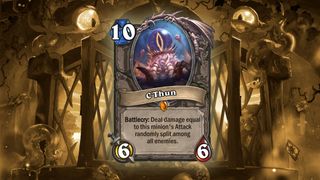
Within the Hearthstone community, there isn’t a pro who’s more associated with the aggro playstyle than Keaton “Chakki” Gill. For much of his career, Chakki has been the prince of SMOrc, the face of going face. So it was slightly surprising to see him winning DreamHack Austin—also his first big tournament triumph, after numerous narrow misses—using a lineup of slow, grindy control decks. (Plus his beloved Zoo Warlock, because some things are too good to change.) But for close watchers, neither the win nor the decks should have come as a shock. The perception of Chakki as simply a rush player is long past its sell by date though.
He’s surprised opponents by picking heavy decks in the past (memorably including Mill Druid at the Root invitational last year) when he thinks the meta is favourable. Chakki is also known for being one of the scene’s finest purveyor of dank meme, but closer inspection reveals one of Hearthstone's hardest workers. As his increasingly regular casting appearances reveal, he’s an analytical thinker with startlingly comprehensive matchup knowledge.
Most players seem to agree that after a new expansion is when the real talent shines, because only the best are able to navigate a meta in flux. So it was entirely appropriate that following the release of Whispers of the Old Gods, DreamHack Austin provided Chakki with his platform to shine. I spoke with him about that win, his thoughts on Standard so far, and much more...
PC Gamer: You must be delighted to have won such a big tournament against such a stacked field, after coming close so many other times. Was your main feeling relief?

Prior to joining the Dignitas Hearthstone team Chakki bounced between the ManaGrind, Clarity Gaming and Team Coast organisations. DreamHack Austin was his fifth appearance in the final of a significant tournament, so in some senses this win has been a long time coming, but his competitive performances have been remarkably consistent. He narrowly missed the cut in our vote for inclusion amongst the 10 best Hearthstone pros in the world last year, (he had one of my votes), but with a significant result under his belt to add to the second place finishes, expect him to be in the mix next time. You can find Chakki memeing on Twitter here and streaming (irregularly) on Twitch here.
Chakki: Yeah, it was definitely a lot of relief in the moment. At first I was just overwhelmed. I took a big drink of water and ran to go do the interview. It was a weird feeling. It felt great.
PCG: What was your read on the meta coming into the event? This was one of the first big events using the Standard format.
Chakki: Since the meta was so new, we predicted players would be all over the place, without a really defined way they wanted to go. So we had two ways to approach it: all-out aggression or all-out control. Aggression didn’t work out too great in testing, and decks like Paladin were really, really powerful—like the N’Zoth Paladin. My friend Nostam came up with a Priest deck based off the Paladin, both using N’Zoth. We added Control Warrior, and I added Zoo at the end. That was the lineup that did the best in our small amount of testing.
PC Gamer Newsletter
Sign up to get the best content of the week, and great gaming deals, as picked by the editors.
PCG: Your reputation as an aggro player has stuck with you since the early days of Hearthstone, but this isn’t the first time you’ve brought a heavy control lineup to a tournament. Do you have a preferred playstyle just go with whatever works?
Chakki: I definitely go with whatever I think is going to give me the best chance, but I think that a lot of the circumstances of the meta and the event led me to go with control. We had public decklists in the top 16, so we were able to take notes. Nobody had really figured out the meta or what they were doing yet, so people had unrefined lists. I wasn’t travelling long, so I wasn’t jetlagged and I felt like I would be able to play control very, very well, whereas flying out to Europe or flying to China like I have before, I generally don’t take control decks, because you can’t trust yourself to play as well there. So everything kind of lined up so I could play control, and I felt that I played it very well.

PCG: That’s interesting, because I’ve never heard anybody factor in the travel like that before. How hard is it to maintain concentration over so many series, especially when your games are running very long?
Chakki: It’s pretty tough to keep concentration the whole day. I mean, it’s really long days, especially when you’re playing the long matchup decks. I think people, even players themselves, underestimate how many mistakes they’re making on a small level throughout the day. They just kind of think, “Oh whatever, it’s fine, I might be a little jetlagged, but I can still play this deck fine.”
PCG: I’ve heard it said that experienced computer programmers make about three mistakes per hour, without noticing. Do you find it’s like that with Hearthstone? Do you make misplays that you only see when you go back through VODs?
Immediately on turn one, when I was roping and not doing anything, I was writing down their entire deck list from memory...
Chakki: I definitely think that happens if you play Hearthstone on autopilot like you’re used to. I know a lot of players don’t use notes, and they think, “Oh, notes don’t help that much”. But after using them for so long, I really think writing things down helps me a lot. I think it helps everyone, but they just choose not to do it. When you play automatically, you will make a couple of errors over the course of time, when you’re playing 45-50 rounds across three days.
PCG: It looked like you were writing an essay at times. What were you noting? The cards the other guy’s played? Reads on what they’ve been doing with their hand?
Chakki: In top 16 we knew entire decklists—they were emailed to us— but we weren’t allowed to have those written down going into the game, we were just allowed blank paper. So going into each match, as soon as we loaded into a game, for mulligans and on turn one, when normally nothing happens, the first thing I’d do is write down how many cards they mulliganed. I track their hand so I can know if they still have a card they kept, but didn’t play going into turn 5 as Shaman, chances are it’s probably a Doomhammer. Stuff like that helps. Immediately on turn one, when I was roping and not doing anything, I was writing down their entire deck list from memory, and I’d just cross out cards from there.
On the next page: Twitch chat racism, Aggro Shaman, and more...
With over two decades covering videogames, Tim has been there from the beginning. In his case, that meant playing Elite in 'co-op' on a BBC Micro (one player uses the movement keys, the other shoots) until his parents finally caved and bought an Amstrad CPC 6128. These days, when not steering the good ship PC Gamer, Tim spends his time complaining that all Priest mains in Hearthstone are degenerates and raiding in Destiny 2. He's almost certainly doing one of these right now.
Most Popular





